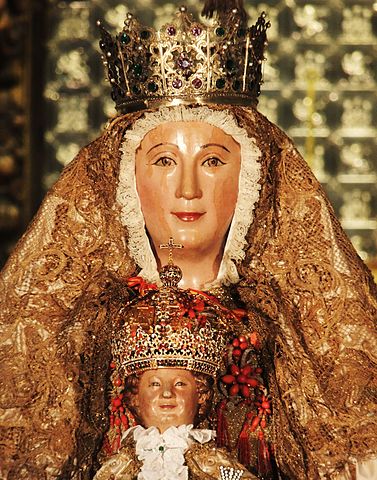By Danièle Cybulskie
While it’s easy to think of the Middle Ages as a backward time in which everyone struggled with the most basic things, medieval people were no strangers to some pretty cool technology, including robots. Instead of using automata (robots) to replace themselves at work, however, the people of the Middle Ages used them for something they found even more important: inspiring devotion.
There is evidence from as early as the thirteenth century of the construction of “robot saints” which could move independently and gesture using complex systems of cogs, hinges, and leather straps, powered by “steam, water, or the latent energy held in a winding mechanism like a clock”. Built mostly from wood, the still-extant Iberian robot Virgin de los Reyes features a painted wooden head, with arms that were covered in white kidskin to give it the appearance of human skin, and hair made from gold thread. She was always dressed in finery. According to Christopher Swift in “Robot Saints”, the Virgin and the figure of Jesus with which she is situated “can perform an almost endless number of human gestures and choreographies” because their arms can bend and rotate in all the same ways human arms can.
Medieval faith had a firm focus on the tangible, so it isn’t really that surprising that robot saints became a part of it. From rosaries to sculpted cathedrals, religious figures were always available for medieval Christians to look at and touch. Special effects were used in early religious drama, and painted wooden effigies were a familiar sight at the funerals of the elite. Automata, in this context, don’t seem to be an odd next step.
There is a famous example of a devotional robot – the Rood of Grace in Boxley, England – that was held up by Protestants in the sixteenth century as all that was wrong with Catholicism. Apparently, this wooden figure of Jesus on the cross could move its eyes and mouth, and was a huge draw to Boxley Abbey.
While the sixteenth-century Protestants were up in arms over this type of robot fooling people into believing in miracles, I think that the truth is much closer to what Swift suggests: “that medieval Christians may have appreciated moveable sacred statues not for their miraculous qualities, but for their mechanical, technological, and ultimately theatrical capacities”. If they considered a stone sculptor’s talent a gift from God, it seems logical that they could equally appreciate the technology behind a moving sculpture – after all, people understood clocks that worked with the same mechanisms.
Besides just making something really cool, it seems (as Swift says) that the aim of creating these robot saints was to inspire contemplation, much like the giant puppets that are still used in religious-themed parades today (and seen in James Bond films). While these robots could be a vehicle for medieval spiritual practice, in the same way as using a relic in hopes of increasing the power of prayer, we shouldn’t automatically assume that medieval people believed that these robots were “real” in the sense that they were living or sentient.
Next time you come across someone who doubts the mechanical genius of the people of the past, show them this awesome (and creepy) video of a sixteenth-century monk automaton, lovingly called “Monkbot” in this really great article by Radiolab on how he works. I also recommend reading Christopher Swift’s article “Robot Saints” in full to get a better sense of how robot saints fit into medieval devotion. Clearly, modern people aren’t the only ones fascinated by the mystery and mechanics of robots.
You can follow Danièle Cybulskie on Twitter @5MinMedievalist















Pentru a putea adăuga comentarii trebuie să fii membru al altmarius !
Alătură-te reţelei altmarius